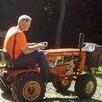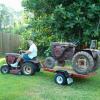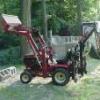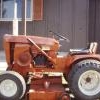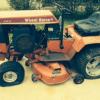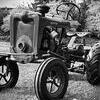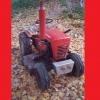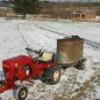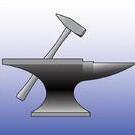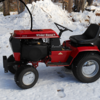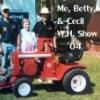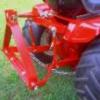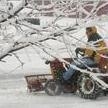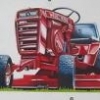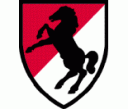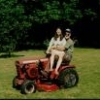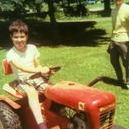Leaderboard
-
in all areas
- All areas
- Markers
- Marker Comments
- Marker Reviews
- Articles
- Article Comments
- Article Reviews
- Classfieds
- Classified Comments
- Classified Reviews
- Wiki's
- Wiki Comments
- Wiki Reviews
- Blog Entries
- Blog Comments
- Images
- Image Comments
- Image Reviews
- Albums
- Album Comments
- Album Reviews
- Files
- File Comments
- File Reviews
- Posts
-
Month
-
All time
November 28 2011 - January 5 2026
-
Year
January 4 2025 - January 5 2026
-
Month
December 4 2025 - January 5 2026
-
Week
December 28 2025 - January 5 2026
-
Today
January 4 2026 - January 5 2026
- Custom Date
-
All time
Popular Content
Showing content with the highest reputation since 12/04/2025 in all areas
-
28 pointsHello, It’s been a while since I posted… Getting started on the restoration of my 1976 Wheelhorse C160, which is about 30% underway… Decided to finish off the year with some new seat cushions for the old style metal seat-pan/back, and member Matt Castagno made me a beautiful replacement. They are so much better than the original cushions, but look absolutely original installed. Such a pleasure to deal with Matt, and arrived in less than a week to California. Spoke to Matt about sharing his email…here it is…Matt’s contact info is: grnlark@gmail.com Hope everyone has a wonderful Christmas and holidays. I’ll be posting more in the new year of the restoration. Best, Jason
-
28 pointsSo my father called all excited today about a 702 tractor he sold to a guy down in Long Island NY. Apparently, the guy he sold it to then sold it to a purchaser for Ralph Lauren. Now that 702 is in the window display at their flagship store on Madison Ave in NYC. Here's a pic of it
-
24 pointsMerry Christmas from the PeacemakerJack family. This is Coulter Caleb’s new house and his fiancée Faith (sitting on her 314H) along with the rest of our family. We started taking these Christmas tractor pictures 11 years ago…a lot has changed since that first picture. I’m so thankful for the many memories made through the years. As Tiny Tim observed, “God bless us…every one!”
-
24 points.. NATIONAL FLASHLIGHT DAY!!! @953 nut how could you have missed this one . Yeah yeah, maybe it’s because I have 200 or so old flashlights here, many are over 100 years old. “National Flashlight Day is celebrated on December 21, coinciding with the winter solstice, the longest night of the year. This day highlights the importance of flashlights, a simple yet essential tool in our lives. Originating from the invention of the dry cell battery and the mini incandescent light bulb, flashlights have illuminated our paths in darkness and served various practical purposes. National Flashlight Day not only celebrates the utility of the flashlight but also aligns with the winter solstice, emphasizing the significance of light during the darkest times.”
-
23 pointsSome of you members who go to the Wheel Horse show, know my Grandson Mason. Well on December 14, we had our first snow, and Mason has his first time driving in it. Unfortunately, he and his Subaru Outback had an untimely meeting with an F-350 pickup truck, his own. This was in the driveway. The F-350 won. He was quite upset but said that it would be back on the road in time for reopening of schools. So, Mason did not want to report it to insurance for obvious reasons, and he did not want to take it to a body shop, so he proceeded to disassemble it. After determining there was no frame or engine damage, he started his search for parts. He found a bumper cover, left fender, and hood, all the same color. He purchased a new core support and radiator, two new headlights, and a grill. He brought the car over to my house yesterday. The whole job was done outside in 15 to 35 degree weather. Total cost? $1400. That's perseverance.
-
22 pointsThe only tractor that was designed and built in Texas is this Jacques Mighty Mite model MM and the subsequent model 10. They were built between 1946-49 in Denison Tx. I believe @oldiron has a model Jaques model 10. I've had one of these on my someday list for quite a while. A special thanks to @Chrishar for finding and helping me haul it to the farm for short term storage. Since it was built in Texas, it's kind of on the level of a Pond RS83 to me. I think it is roughly the size of a Pond, and some what similar in design. They don't have the following that a Pond has, so thankfully they are not in that price range. I've read somewhere between 35500 to 5000 were built under a couple of different names/owners The angled bracket on the rear hitch was a plow mounting bracket. The front wheels are a 2 piece split rim, the same as on a David Bradley 2 wheel tractor or an early Sears/David Bradley The front axle has Jaques Mighty Mite cast into it. The original engine would have been a Briggs 23 or some later ones had twin cylinder Wisconsin's. Someone did a nice job of retrofitting an electric start Kohler K301 into it some wherein the past. The clutch linkage is stuck, but looks complete. I need to learn if this is the original "Twin-Disc" clutch o that was done when the Kohler was installed. It has the original foot and hand clutch, but the hand clutch handle has been modified I need to figure out was transmission this is. it is a 3 speed with reverse and a top access gearbox. The rear axle is a shortened Ford Model T "Banjo" axle. The rear axle has drop boxes on it made by Jaques, then looks like it uses the Ford Brakes and Hubs. Lots to do to get it working.
-
21 pointsDid something crazy today! Drove 735 miles from Andover Ct to Shippensburg Pa (round trip) took me 13 hours and 10 minutes, spending $130.24 on fuel…to come home with a C-145 Hydro. My wife packed me a lunch, snacks and a couple waters so I only had to purchase a coffee. Left my house at 5:30am and pulled back into my driveway at 6:40pm. Was supposed to be a clear day…hardly! Hit snow on I84 west headed to Scranton Pa, and hit it again on the way home . But no hiccups or truck issues so I’ll say it was a win!
-
21 points
-
21 pointsThere was a fair amount of wear on the ends of the C81 Clutch Shaft where it goes thru the frame. Metal on metal, no bearings & not easily lubricated. I installed the bronze bushings on the 502 frame a while back, using the milling machine. The C Series has two sets of welded 3/4" diameter rods to hold the foot rests, the rear ones were in the way - could not do this in the milling machine. There were 3 choices - cut the rear rods off & reweld them later, do the work by hand, or - break out the 1950's ShopSmith 10E and use it. I went with option #3 - while the assembly & setup are extensive, it gives the best results. Pictures are for the RH bearing: the setup needs to come apart and be reassembled opposite hand to do the left.
-
21 pointsWe were aboard the U.S.S. Missouri a little while back, just after our visit to the U.S.S. Arizona memorial. Aircraft carrier U.S.S. Nimitz came into port. I muted the majority of the audio, and chose to enjoy some waves. Some of the mindless chatter behind me seemed to take away from the moment. I thank each and every service member, from the bottom of my heart.
-
20 pointsHere I go again. As the title says, this years project is a 401 Suburban. Will start off with some ground 0 pics. Next step that I was happy about was my Christmas Miracle. The steering wheel came off without special tools or much resistance. When I bought the tractor it had a Nova ignition module on it. Starting it was sometimes a challenge so I wanted to switch it back to points before disassembly. Happy to say that it starts much better on points than it did with the Nova module. With this accomplished it was time to move on to tear down. A couple of hours later & I had a pile of parts. I went through the transmission shortly after I bought the tractor because it had a 3rd gear issue, so that will not have to come apart again. The engine runs good with no smoke, so hopefully it will not need a rebuild. It does appear to be seeping oil from the head gasket, so I will pull the head to change the gasket. Will also inspect cylinder condition as long as it's open. Now for some P.O. surprises. Lets just say that some people should not be allowed to play with welders. First, when a lock collar cracks I guess one should grab the welder & tack it in place. Drag link issue?? Lets burn that in place too. I'm sure there will be a few more surprises. Feel free to come along for the show.
-
20 pointsSorry for the long post, but this story needs to be told. My oldest Grandson Reed has a fellowship granted for his Astro Physics PHD at Lehigh University. He has been there for 2 years and has 2-3 years left. Last year he got tired of paying the college town land lords rent and bought one of the row houses to house himself and a couple room mates. His Dad Mike operates a HVAC/ Plumbing business so he installed a new gas furnace and a new Mini Split air/heat pump System. The existing gas hot water heater was only 2 years old and tested good so it was not replaced. Mike also installed smoke and carbon monoxide detectors as required for a rental property. About two weeks ago a CO detector tripped. Reed reset it and all was OK, but Mike sent him a second CO detector as a back up. Friday when Reed came home the CO detectors were sounding and when reset they kept tripping. He called his dad and Mike told him to disconnect the main breaker, open the doors, go out and wait in his car till he got there. Mike called the local fire company and left for the 2 hour trip to Bethlehem. He suspected the gas hot water heater that he did not replace could be the problem. When Mike got there, the fire company had allready checked Reeds house and appliances and could not find the source of the CO. They went to the attached row house and found the house was filled with CO from a faulty furnace and the family of five were all sick with flu like symptoms. Thankfully the loose stone basement foundation wall allowed the CO to leak into Reeds basement and trip the alarms and thankfully Reed did not come home for the weekend and was there to hear the alarms or the outcome would have been much different. Per the fire company, the family would not have survived the night. Sometimes we get lucky. Don't rely on luck...install smoke and CO detectors for everyone you care about.
-
19 pointsWe got a few inches of the white stuff today, daytime temps in the 20's. Used all three of the seasoned "Snow Angels" - 1979 C81, 1964 854 8 Speed, and the 1976 Ariens 24" Snow-Thro. The Snow Shovel not shown has only 8 years on the job, gets an "Honorable Mention" ...
-
19 pointsMaybe not. Looked out in the back yard last night to see a black bear working on the bird feeders. Opened the door and asked him to leave ... he wandered off but was back 10 minutes later.. Today I went out to find the feeders and see where he had been. We are having some work done and the contractor has a dumpster and a porta-potty. set up. Bear tracks went right up to the door of the porta-potty
-
19 pointsThe first notes are on papyrus ... that's an indication of how long @ebinmaine's been "working " on it... Trail cam of Eric ordering the first parts list...
-
19 pointsMade sure my plow rig was ready for tomorrow’s possible snow event. Won’t be a deep snow but still needs to be cleared off the driveway. One headlight…but like most of ya’ll I have spare old/used ones kicking around. My 510-8, half the horsepower but twice the dependability!!!
-
17 points
-
17 pointsThe right-rear axle seal in my 522xi failed rather suddenly, as evidenced by the oil slick that appeared overnight on the garage floor. I jacked up the rear end and checked for play in the bearing, as well as end play in the axle. All was snug and smooth, so I figured that the rubber portion of the seal probably split or became detached from its metal ring. So, off with the hub. I loosened the set-screw jam nuts, heated the set screws just enough to soften up the factory-applied thread-locking compound, and removed them, using a 3/8” square (4-point) socket. I was going to use a three-jaw puller to remove the hub, as shown in the service manual. However, the hub appears to be cast iron, and I saw that some forum members had broken a hub flange with a puller. I could have used a bearing separator to pull the hub by flipping the jaws front-to-back and placing it directly right behind the flange, contacting the hub reasonably close to the center, but I opted for a more ‘elegant’ solution: I made a custom hub-puller that I could use again for future repairs if/when needed. It didn't take long to make. I traced the wheel hole pattern onto a scrap piece of 3/8" steel plate, drilled five 15/32” holes (for 7/16” bolts), drilled a 25/32” hole in the center, and welded a 3/4” grade 8 nut to the plate. I would have made the plate round, but I didn't have a wide enough piece of 3/8" plate, so it's in the shape of a pentagon. I figured that pulling from five points instead of three, and with those points closer to the center of the hub than its edge, there wasn’t much chance of breaking the casting. Also, before applying any pulling force, I snugged up all five of the 7/16” bolts finger-tight to make sure it would pull evenly from all five points. It worked “slick as snot on a glass doorknob,” as an old employer of mine used to say. As I suspected, the rubber portion of the seal had partially separated from its steel outer ring. I pried the seal out, being careful not to scratch the axle or transmission mating surfaces. I also checked for burrs on the axle, to avoid scratching the new seal when installing it. I made a simple seal installation tool by turning down a piece of schedule 80 PVC pipe in my lathe, which worked fine for installing the new seal. I’ll improve that tool later by inserting a thin sleeve inside it for a closer fit over the axle. Here's my hub service 'kit,' consisting of the puller, the 3/8" square socket, and the plastic seal installer, which I'll keep together in a bin for later use. I re-installed the original plastic thrust washer, which had a few thousandths of wear, but was still in good condition. I also installed a new key, even though the old one looked fine, and I cleaned and dried the set screw threads in the hub, so that the Loctite would work properly. The hub was still a snug fit on the axle, and I tapped it into place with a dead-blow plastic hammer to the point where there was only about .002 or .003 inch of end play in the axle (in other words, I tapped the hub far enough on to the axle to make up for the slight wear in the plastic thrust washer). I then installed new grade 8 square-head set screws with Loctite 271, torqued them per the service manual specs (28-32 ft. lbs.) and tightened the jam nuts. Done, no leaks, and I have a tool that will make any future hub work easier.
-
17 pointsThe leads going to the cruise control electromagnet on my 522xi showed definite signs of having served as a meal or nesting material for a mouse or some small furry critter. All but one or two strands of the wire were chewed through: Not a difficult repair job. Cut/strip/crimp: First layer of heat-shrink tubing: Second layer of heat-shrink tubing: Wires fixed. I managed to clean and save most of the original outer jacket/loom: Electromagnet reinstalled: Rounded up the usual suspects, but had to let this one go for lack of evidence:
-
17 pointsI ordered some stuff from Wheel Horse Parts and More and thought the shipment was short. Sent a text and received almost immediate response. As it turned out the problem was on my end. Joette helped with the issue. Thanks, JoeM In today's world we pretty much hear the bad and hardly any of the good stuff. Just wanted to share.
-
16 pointsDon't want to jinx anyone here in Maine but have not seen piles of snow here this high in a few years. This was cleaned up with multiple machines. Good ole time Maine Wintah.
-
16 pointsI had my doubts this 16(14) Automatic "Johnny Cash" would ever be anything other than a parts donor, but here we are!
-
16 pointsWeld da hood shut baby. No more trouble wid dis one. Dry as mojave and purring like a kitten..
-
16 pointsI wonder if she ever said “Is that a flashlight in your pocket, or are you just glad to see me?” 🤣🤣🤣
-
16 pointsFor the little town of Knox local we have already exceeded half the normal snowfall for the season. Several springs ago I picked up this tall chute from a member in PA. The only use it's had was just when I wanted to play with it. That is until this year. A recent snowfall of 10+" of very heavy wet stuff won the battle with the Reborn B-80 blade tractor. I fired up the 05 with the blower and it did the trick. But I was on and off the seat multiple times to adjust the chute deflector. I just eliminated that problem this morning. I didn't want anything 'permanent' on the tractor. The 6" stroke proved to be perfect mounted like this. I did a little video but I can't get it to transfer to YouTube.
-
16 pointsI got several things I need to get finished, but my Bronco has been marking it's territory in my garage. One axle seal was leaking quite a bit, and I had not seen it because of how it was previously parked. Guess I should get it out more, right? As is usually the case, a leaky axle seal left alone long enough made the hub removal super easy. Didn't even need my puller for it (lucky since I couldn't find the darn thing). Anyway the hub came right off with some wiggles. Made a couple small dings in the metal face of the new seals because it was crazy tight but it shouldn't affect it. The axle and bearing seems fine. A couple hours after and no leaks yet. I'll try to get it out over the holidays and see for sure, but so far so good.
-
15 pointsAll: Having "moved" both spindle bores when I machined it for bushings, I realized I now needed slightly shorter length Tierods. I have used regular 1080 Cold Rolled material for another set, but the quality of the machined threads was lacking. This set I switched to 12L14 "leaded" hexstock - per the certificate it has .27% lead in the alloy. This allows easier machining with a superior finish. Cost is just a couple of bucks more than 1080. The threads shown are done with an adjustable thread cutting die - 3 passes needed to get the proper shaft to nut fit. Shown is the die from the final pass - the chips look like angel hair Also shown is the old trick of having a starting pilot diameter for the die - it is removed once the threading is done. The 12L14 material is safe to work with, but sanding, grinding and welding are NOT recommended...
-
15 pointsPut a new brake pedal return spring on my '75 B100 Auto a couple weeks ago and when I was done the engine wouldn't crank with the ignition switch. No click, nothing, but I could turn the key to the run position, jump the solenoid and it would start right up and keep running. Switch tested good and I tried another known good one, same for the solenoid. The seat saftey switch was long gone when i got it. I replaced a sketchy looking splice in the lead to the solenoid and also put a new terminal on it. I did find that somewhere in all this the terminal for the battery negative cable had snapped off where it was fastened to the frame so I put a whole new cable on, still nothing. I had continuity across the switch but when I checked from the switch to the solenoid nada. I pulled the rectifier/ammeter mounting plate to take a look at the wiring to the switch from there. Ammeter had been bypassed years ago. I had juice from the switch to the rectifier but nothing to the feed running to the solenoid. I started to suspect the PTO safety switch...... That's when it hit me, I gave the PTO lever a pull and it moved backward, it had gotten bumped forward just enough to break the circuit..... put it all the way back, hit the key and it spun right over. Realizing I'm a moron never felt quite so good LOL. I did however take care of at least 3 future wiring problems so it wasn't a total loss. Thought I'd share that, always make sure everything is in the off position even if you "know" it is. All it took in this case was a few degrees of rotation and my total confidence it was an actual electrical issue..
-
15 pointsStuck these lights on the 1257 today just to see what they look like. The holes are already there so dont know if I want to fill them in, leave them alone, or run these lights? They would be handy in the dark of night . What is everyone’s opinion?
-
15 pointsPictured below is a gift and card (on nothing less than notebook paper.) my ten year old granddaughter gave me. She told me she bought me a Christmas gift (with her own money her mom said.) a couple of weeks ago. The school had some kind of sale and Gracelia found these pliers and snatched them up. The other side of the card said "TO: You FROM: Cece" These pliers will not likely be put to use on the 520H. They, along with the card, will be hanging on my "wall of memories" in the shop and remain there as long as I'm able to be out there tinkering around.
-
15 pointsIt’s back in action. Little better than I found it. Enjoy the YouTube video YouTube Video
-
15 pointsThe other day I picked up a No name 14 from a friend of mine who has been in this hobby a long time. I have been eyeing this machine for the last couple years. I did NOT need another machine by any means but gladly added this one to my collection! Pic right after I got it and once I got it home cleaned up with a new seat!
-
15 pointsYesterday we got some snow. Saturday I put the blade on the c-145 since my C-120 that is supposed to have a plow on it is in pieces. Yesterday morning put a new scraper blade from a public works snowplow on. That should last awhile! Then it was time to shine. Love plowing fluffy snow! And today did a bit more cleanup. IMG_1281.mov
-
15 pointsI picked up another WH very close to home. 2 miles away. The fellow moved into a new housing plan with very little yard and no need for it. Very good price as it is off season here.He said it was used to mow a half acre field next to his old house about 6 times a year. I think I have to believe him. No rust just dirty which I will address. It will need a new seat and a hood as he said the hood met with a tree limb. Deck shows no rot or rust at all. Oils are clean. He said he serviced it regular. To dang cold to do much yet. Will probably start with the deck first for a good power wash when weather permits. It will be a camp tractor. It does have the 15 amp charging system. It probably will become a Burgundy stripe machine. 1990 vintage.
-
14 pointsChanged out the powered worm gear snowblower chute with a powered chain drive.
-
14 points
-
14 points
-
14 pointsSacrilege or not I wanted some new wheels, tires, hubs, and lugs. Put old shoes on my L-156.
-
14 pointsWhy all the snowmen decorum, and not of me! I've been slighted and disrespected. I think Karl may get some coal in his stockings this year.
-
14 pointsReceived this much appreciated Tee Shirt today. It also relates to Tractors... enjoy! Percussive Maintenance - Stuck Carb Needle High Impedance Air Gap - Rectifier Connector fell off Cycle Power to the Panel - Battery Charger not working Thermally Reconfigured - The dreaded 9-Pin Connector Kinetic Disassembly - Balance Gear Failures
-
14 pointsI agree with Achto that too much weight may cause something mechanical to let go, a little tire slip is not a bad thing. I have a 1979 c-101 with (turf tires and 2 link chains) (best combo in my opinion for snow) 80 lbs on each rear wheel and # 40 chain on fronts for steering. A 10" cement block filled with cement, (weight unknown) on rear and have zero problem pushing as much snow as the plow can handle. It has been set up this way for 40 plus years with no mechanical problems, and has moved tons of western Pa snow ( Laurel Highlands). Bob
-
14 pointsHey guys, Well, greetings from way out here on the West Coast in California. Not too many members out here. I don’t think, seems like there weren’t a ton of our tractors here although mine is an original one owner Tractor before me who purchased it in Escondido California. (I’ve owned it for a decade). I have all of the records of everything, including the original bill of sale. It’s wonderful. Anyhow, today was day-one of disassembly, and as this has been a working Tractor for several years now, everything came apart beautifully. No frozen nuts. It has basically been effortless. So, all of my experience is with the restoration I did on CASE 444 tractor, But the nice thing is the similarities between the two for many things. I plan on upgrading the steering arms using Heim joints instead of the ball and socket joints… It was a huge improvement on my CASE. I’m sure I’ll have some questions going down the road, but the beautiful thing is I am finding almost zero corrosion, except the panel area inside… is that aluminum or magnesium? It’s got some powdery corrosion on it. Best to you all, Jason
-
14 pointsWe got a few inches of snow over the last few days. Not enough for the snow blower on the GC 2410. But if I didn’t clean it up, it would be a mess. So I drug out the 314-8 and took the mower deck off. Put the front and rear wheel weights on and the chains. Gassed it up. Got my 42” plow put on. Couldn’t find the short lift link to go to the deck lift arm, so I made one out of a piece of garage door opener lift arm and a couple clevis pins. Done. I haven’t really ever plowed snow with the 314-8. Have a blower for it and always used that, until I got the blower for the GC. It worked great, and didn’t dig up the gravel driveway much. Good seat time today.
-
14 pointsMine got a work out this morning and they performed great. I got nearly 4 hours of seat time clearing 4 inches of wet snow from 7 driveways and mail boxes.
-
14 points
-
14 pointsShe plows! Still need to work on the lift stuff. Try to get another inch of lift, check which lift holes were used etc. Cruised down to the old shed to see if I have any “trapped” mice (aka, DEAD!)
-
13 pointsThere are way too many "lower life forms" that sell WH parts on CL and FB Marketplace. They are not one bit interested in preserving the hobby, just the color of folding money. I have had mostly decent transactions on Fleabay - but the most accurate, knowledgeable and honest are the folks here on Red Square....
-
13 pointsPut new 24-12-12 tires on C160. They are Horseshoe brand will try and post more info on them in lets talk tire thread.
-
13 pointsLooks like a J.C. Whitney universal bumper add on hitch so you can tow a 10,000lb. trailer with 67 Dodge Dart!
-
13 pointsThe plastic front ‘bumper’ (for lack of a better term) of my 522xi had a chunk broken out of it and several cracks radiating from that spot. Fortunately, I had the missing piece, which made the repair a little easier. After thoroughly cleaning and degreasing the area around the breakage, I stuck the piece back in and cemented the cracks with a water-thin plastic solvent cement that had good capillary action to flow into the cracks. Here’s the back view of the breakage area after applying a few applications of the cement. It seemed to work very well. Even though the cracks were completely welded shut, I shifted into my usual over-engineering mode and decided to reinforce the back of the repair with a few layers of thin fiberglass cloth. I wanted a molecular bond between the fiberglass cloth cement and the plastic, rather than mechanical, so instead of something like epoxy or polyester resin, I used a thickened plastic cement that exhibited some solvent action on the plastic. Here's the back of the bumper with at least three layers of fiberglass cloth adhered with the plastic solvent cement and with a coat of red paint over it. This part of the bumper won't be visible. Here's the front after gluing, sanding, and a coat of clear “Adhesion Promoter” primer: And the damaged area after the first coat of Regal Red paint (two more coats to go). The color looks a bit off because the photo was taken in the shade. Note: The red bumper is made of PC-PET plastic (a blend of polycarbonate and polyethylene terephthalate). The black bumpers on similar models (such as my New Holland GT18 / 518xi clone) are made of ABS plastic. However, the cements that I used were actually designed to be used with other types of plastic, such as acrylic or PVC, but they still had a solvent action on the bumper and seemed (to me) to work fine. I guess time will tell.
This leaderboard is set to New York/GMT-05:00
-
Newsletter

